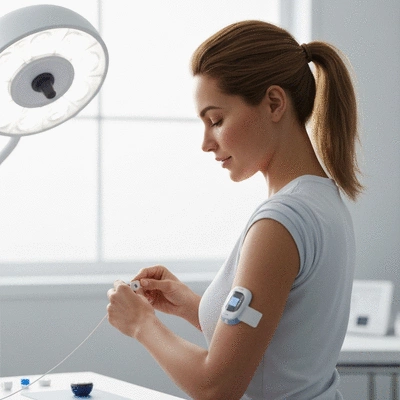CGMs or Traditional Testing: Choose Wisely

Wondering how to choose the best glucose monitoring method for your diabetes management? You’re not alone. With advancements in technology, understanding the differences between Continuous Glucose Monitors (CGMs) and traditional blood glucose meters can empower you to make informed choices for your health.
What You Will Learn
- CGMs provide real-time glucose data, offering insights into how lifestyle choices impact blood sugar levels.
- Traditional blood glucose meters require finger pricks but offer a simpler, one-time snapshot of glucose levels.
- Cost considerations vary between CGMs and traditional meters, with CGMs generally having higher initial expenses but potentially greater long-term value.
- Health insurance coverage for CGMs can differ; it's crucial to check your specific plan for coverage details.
Continuous Glucose Monitors vs. Traditional Blood Glucose Meters
A comparative overview of features, costs, and insurance for effective diabetes management.
Continuous Glucose Monitors (CGM)
- ✓ Real-time readings every few minutes
- ✓ Alerts for high and low glucose levels
- ✓ Trend data for pattern visualization
Cost: Initial $200-$800, ongoing $100-$300/month
Insurance: Often covered, check provider for specifics
Traditional Blood Glucose Meters
- ✕ Requires finger pricks (uncomfortable)
- ✕ Provides snapshot readings only
- ✕ Less frequent monitoring, can miss trends
Cost: Meter $10-$50, strips $30-$100/month
Insurance: Generally covered for meters & strips
Decision-Making Framework
Consider these questions when choosing your monitoring method:
- • Daily routine & check frequency needs?
- • Experience frequent blood sugar fluctuations?
- • Comfort with technology vs. traditional approach?
- • Budget for diabetes management tools?
Understanding Continuous Glucose Monitors and Traditional Blood Glucose Meters
As someone who has dedicated over a decade to diabetes care, I often find patients wondering about the differences between continuous glucose monitors (CGMs) and traditional blood glucose meters. Both tools aim to help manage diabetes effectively, but they do so in different ways. Let’s explore what each method offers and how they can impact your daily diabetes management journey.
What is a Continuous Glucose Monitor (CGM)?

A Continuous Glucose Monitor (CGM) is a device that tracks your glucose levels in real-time throughout the day and night. Unlike traditional meters that require finger pricks, CGMs use a small sensor placed under the skin to measure glucose levels continuously. This technology allows for immediate feedback on how your lifestyle choices affect your glucose levels! Additionally, studies have shown the effectiveness of CGMs in providing a comprehensive view of glycemic control, as detailed in research comparing Continuous Glucose Monitoring and Blood Glucose Monitoring.
- Real-time glucose readings every few minutes
- Alerts for high and low glucose levels
- Trend data to visualize changes over time
With these features, CGMs not only provide current glucose levels but also help identify patterns. This can be a game-changer for making informed decisions about diet and insulin use.
How Does Traditional Blood Glucose Testing Work?
Traditional blood glucose testing involves using a small device known as a blood glucose meter. You simply prick your finger to obtain a drop of blood, place it on a test strip, and the meter calculates your blood sugar level. This method is straightforward and widely used, but it only provides a snapshot of your glucose level at that moment. While effective, traditional methods offer less comprehensive data compared to CGMs, as highlighted in a study on Blood Glucose Monitoring methods.
- Requires finger pricks which can be uncomfortable
- Results can fluctuate significantly throughout the day
- Less frequent monitoring, can miss trends
While traditional testing is effective for many, it might not offer the comprehensive insights that a CGM does, especially for those needing constant monitoring.
Comparing Sensor Technology in CGMs and Traditional Meters
The technology behind CGMs and traditional meters differs significantly. CGMs utilize tiny sensors that continuously measure glucose levels in the interstitial fluid, thus offering a dynamic view of your glucose trends. In contrast, traditional meters rely on blood samples, which provide only specific, isolated readings. The advancement in CGM technology, particularly in non-invasive glucose monitoring, is a rapidly evolving field, with promising research like that published in Nature Scientific Reports on non-invasive glucose monitoring continually pushing boundaries.
- CGMs provide continuous data and trends
- Traditional meters offer discrete, momentary readings
- Sensor technology in CGMs can lead to better overall glucose management
Understanding these differences helps you choose the right method for your lifestyle and health needs. As we delve deeper into comparing these two methods, consider how each option aligns with your personal diabetes management goals.
Pro Tip
When considering between a Continuous Glucose Monitor (CGM) and a traditional blood glucose meter, think about your lifestyle and how each method fits into your daily routine. For those who travel frequently or have a busy schedule, a CGM might provide the convenience of continuous monitoring without the need for constant finger pricks. However, if you prefer a more hands-on approach or have budget constraints, a traditional meter could still be an effective choice.
Making an Informed Decision: CGM vs. Traditional Testing
As someone who is dedicated to empowering individuals with the tools they need for effective diabetes management, I understand that choosing the right monitoring method is crucial. Whether you prefer a Continuous Glucose Monitor (CGM) or a traditional blood glucose meter, it's essential to weigh your options carefully. To assist you in this decision-making process, let’s explore a personalized framework for selecting the monitoring method that aligns best with your lifestyle and health needs.
Personalized Decision-Making Framework for Choosing Monitoring Methods

When deciding between a CGM and a traditional blood glucose meter, consider your unique circumstances. Here are some questions to guide your decision:
- What is your daily routine like, and how often do you need to check your glucose levels?
- Do you experience frequent fluctuations in your blood sugar levels?
- Are you comfortable using technology, or do you prefer a more traditional approach?
- What is your budget for diabetes management tools?
By reflecting on these questions, you can better determine which monitoring method will meet your needs. Remember, there’s no one-size-fits-all solution—what works for someone else may not work for you!
Cost and Insurance Insights for Each Monitoring Option
Cost is a significant factor when considering glucose monitoring methods. Traditional blood glucose meters generally have lower upfront costs but may require ongoing expenses for supplies like test strips. On the other hand, CGMs often entail a higher initial investment, but this can be offset by the increased data and convenience they provide. Here’s a quick breakdown of the costs:
- **Traditional Blood Glucose Meters:** Typically range from $10 to $50 for the meter, with monthly costs of $30 to $100 for test strips.
- **Continuous Glucose Monitors:** Initial costs can be $200 to $800, with ongoing sensor costs ranging from $100 to $300 per month.
Understanding these costs can help you create a budget that fits your diabetes management plan. Don't forget to factor in potential insurance coverage!
Exploring Health Insurance Coverage for Continuous Glucose Monitors
Many health insurance plans now cover CGMs, recognizing their value in managing diabetes. However, coverage can vary significantly between plans. Here are some steps to explore your coverage options:
- Check with your insurance provider to see if they cover CGMs.
- Ask if your plan has specific preferred brands or models.
- Inquire about any co-pays or deductible requirements for CGM supplies.
- Consult your healthcare provider for documentation that may be needed to support your request for coverage.
Being informed about your insurance coverage can make a significant difference in your decision-making process. If you have any questions, don’t hesitate to reach out to your healthcare team for guidance.
Frequently Asked Questions (FAQs)
Q: What is the main difference between a CGM and a traditional blood glucose meter?
A: A CGM provides real-time, continuous glucose readings and trend data using a sensor under the skin, offering a dynamic view of glucose levels. A traditional blood glucose meter requires finger pricks and provides snapshot readings of glucose levels at specific moments.
Q: Are CGMs more expensive than traditional blood glucose meters?
A: Typically, CGMs have a higher initial cost ($200-$800) and ongoing monthly sensor costs ($100-$300). Traditional meters are less expensive initially ($10-$50) but incur ongoing costs for test strips ($30-$100/month).
Q: Does health insurance cover Continuous Glucose Monitors?
A: Many health insurance plans cover CGMs, but coverage varies. It's essential to check with your insurance provider about specific plan details, preferred brands, co-pays, and deductible requirements.
Q: How can I decide which glucose monitoring method is right for me?
A: Consider your daily routine, how often your blood sugar fluctuates, your comfort with technology, and your budget. Discuss these factors with your healthcare provider to choose the best method for your individual needs.
Q: What are the benefits of using a CGM?
A: CGMs offer real-time data, alerts for high and low glucose levels, and trend analysis, which can help in making informed decisions about diet, exercise, and medication adjustments, leading to better overall diabetes management.
Recap of Key Points
Here is a quick recap of the important points discussed in the article:
- Continuous Glucose Monitors (CGMs) provide real-time glucose readings, alerts for high and low levels, and trend data for better management.
- Traditional blood glucose meters require finger pricks and offer snapshot readings, which may miss important trends.
- Choosing between CGMs and traditional meters should consider factors like daily routine, frequency of blood sugar fluctuations, comfort with technology, and budget.
- Understand the costs associated with each method to create a feasible diabetes management plan, considering insurance coverage where applicable.
- Consult with healthcare providers for guidance on the best monitoring method suited to personal health needs.








